Located on the western margin of the Deccan plateau, is the city of Pune, known to have existed as a town since 847 AD. Pune rose in prominence during the reign of the Marathas.
The oldest reference to Pune has been discovered on a Rashtrakuta Dynasty copper plate dated 937 B.C.E. Pune is also fondly known as the Oxford of the East. The city has been the birthplace of country leaders like Shivaji and Lokmanya Tilak. The most widely spoken language in this area is Marathi.
Pune experiences a tropical wet and dry climate. The summer months are from March to May. However, the maximum temperature does not go beyond 40 degrees. The monsoon season commences in June and continues till October with the average temperatures ranging between 20 to 28 °C. Winter usually begins in November and lasts till January. March to May are the month which should be avoided by tourists when visiting Pune.
The charm of this quaint city of Pune lies in its varied topography and the forts and caves which are tucked in the surrounding hillocks. Some of these sights prominently figure in the history of the Marathas.
Shaniwar Wada: Built by the King Baji Rao in 1730, the Shaniwar Wada is a stately mansion originally built as the residence of the Peshwas rulers of the Maratha Empire. The palace is situated near Mula River, and comprises fountains, residential quarters, audience halls and courtyards. Visitors can get a glimpse of the Maratha history through the hour-long sound-and-light show in the evenings here.
Raja Dinkar Kelkar Museum: This museum was established in 1962 by Baba Dinkar Kelkar himself, in the memory of his son. The museum houses 21,000 rare exhibits from all over the country, some of them dating back to the Mughal and the Maratha periods. The ‘Mastani Mahal’ which was reconstructed in the museum is a major attraction here.
Saras Baug: Located against the background of the beautiful Parvati Hills is this renowned temple. Dedicated to Lord Ganesha, this temple was constructed in 1774 by Madhav Rao Peshwa.
Aga Khan Palace: Set across the Mula River in Yerwada, the grand Aga Khan Palace & Gandhi National Memorial was built in 1892 by Sultan Aga Khan III. Its ia crowd puller because both Kasturba Gandhi, Mahatma Gandhi’s wife died here in confinement.
Other than the in house tourist attractions, hill stations like Panchgani and Mahabaleshwar serve as good options for weekend getaways from Pune.
As far as food is concerned, the traditional Pune food is based on sorghum and pearl millet. Some of the must haves here include Misal Pav, Puran Poli, Pithla bhakri and bhelpuri. Mastani, a thick milkshake containing dried fruit, is another speciality which Pune has to offer.
What makes the city attractive further is the fact that it is one of the rare cities in India which is considered very safe even during the night. Situated on the leeward side of the Sahyadri mountain range, the city of Pune continues to retain its repute as the cultural capital of Maharashtra.










